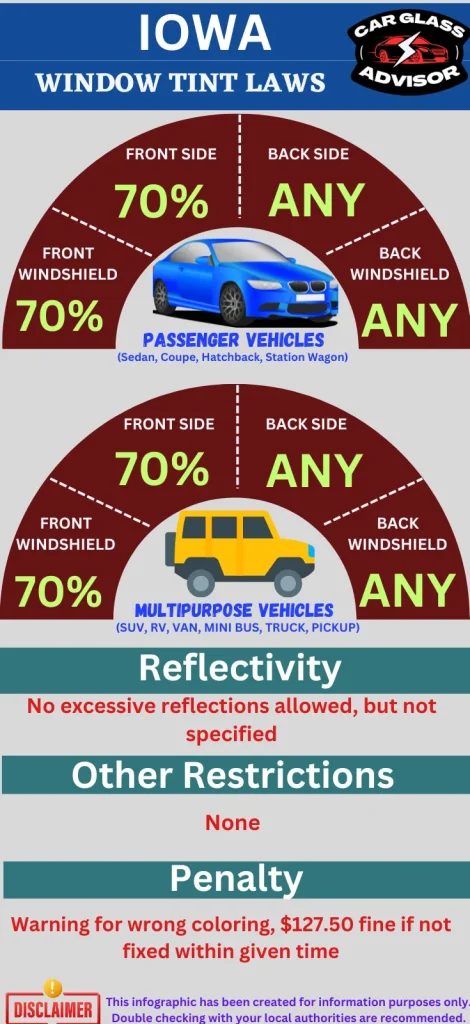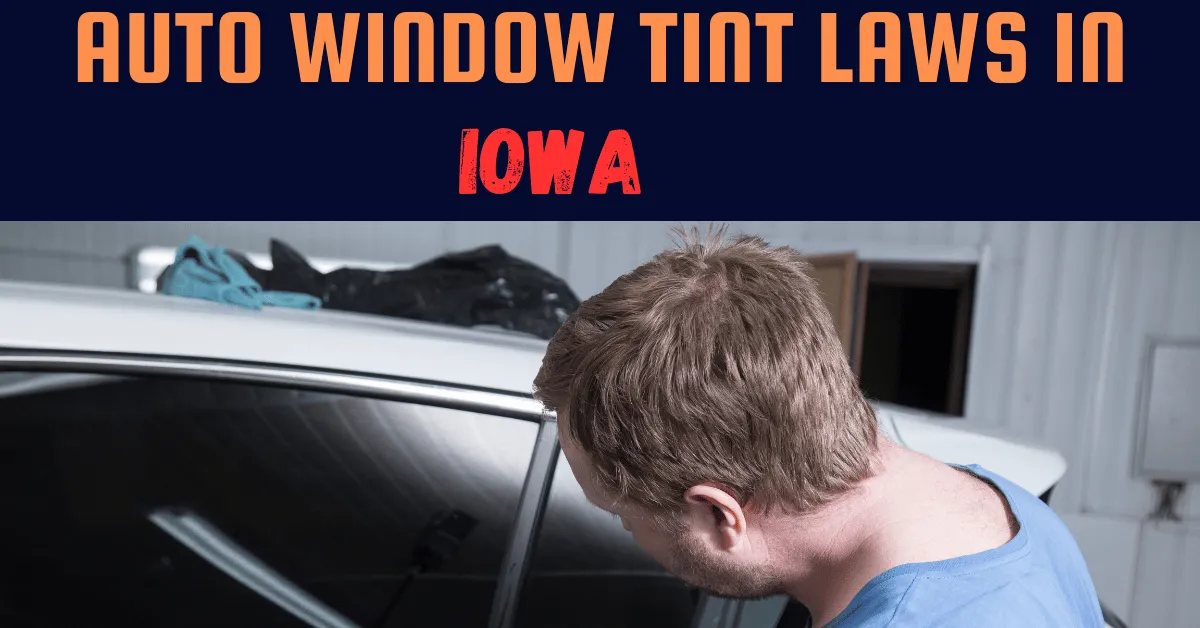In 1983, Iowa set forth car window tinting laws to regulate the level of darkness and reflectivity of tints on vehicles. As a conscientious driver, you’ll want to ensure your compliance with the guidelines by obtaining all the relevant information and documents about your car’s window tint. Beyond the basic standards, Iowa also enforces supplementary rules and regulations for car window tinting. It’s essential to familiarize yourself with these specifications to avoid the risk of receiving hefty fines. By taking the time to educate yourself on the state’s car window tinting policies, you’ll be able to cruise confidently and safely on the roads.
If you’re looking to get your car windows tinted, you should know about TWO KEY concepts: Visible Light Transmission (VLT) and Visible Light Reflection (VLR). In this discussion, I’ll explain both concepts, starting with VLT.
1. Window Tint Darkness in Iowa (VLT)
Window Tint Darkness or Visible light transmission (VLT) is a measure of the amount of light that passes through a film. It’s measured in percentages and can deviate from 0% to 100%. The higher the percentage, the more visible light is transmitted through the film.
Every state has distinguishing legal limitations. Therefore, it’s important to note that the allowable amount of light transmission through tinted glass in Iowa may differ from other states, and the standards may also vary between passenger vehicles and multi-purpose vehicles. To ensure compliance with Iowa’s specific tinting laws, it’s crucial to take the time to carefully read and understand the regulations. By doing so, you’ll be able to determine the optimal level of tinting for your vehicle while avoiding any potential legal repercussions. So, whether you’re driving a passenger vehicle or a multi-purpose vehicle, be sure to review Iowa’s tinting laws thoroughly to guarantee you’re in full compliance.
Tint darkness laws for passenger vehicles (sedans) in Iowa:
Windshield: Windshield of a passenger vehicle must allow more than 70% of light to pass through. This means that the tinting or any other material applied on the windshield should not be so dark that it reduces the amount of light that can pass through the windshield to less than 70%.
Front Side windows: You can use maximum 70% tint darkness.
Back Side windows: You can use any tint darkness for backside windows.
Rear Window: You can use any tint darkness for rear windows.
Tint darkness laws for multi-purpose vehicles (SUVs and vans) in Iowa:
Windshield: Windshield of a multi-purpose vehicle must allow more than 70% of light to pass through. This means that the tinting or any other material applied on the windshield should not be so dark that it reduces the amount of light that can pass through the windshield to less than 70%.
Front Side windows: You can use up to 70% tint darkness for front side windows.
Back Side windows: You can use any tint darkness for backside windows.
Rear Window: You can use any tint darkness for rear windows.
2. Window Tint Reflection in Iowa (VLR)
Window Tint Reflection or Visible light reflection (VLR) is the amount of light that a window film reflects. For measuring the level of window tint on your vehicle, VLR (Visible Light Reflection) is a crucial factor to consider. Iowa’s car window tinting laws specify the permissible VLR percentage for tints, which ranges from 0% to 100%. A lower VLR percentage shows that less visible light is reflected into the car, resulting in more sunlight being blocked. To avoid any legal complications, it’s also crucial to be mindful of the VLR requirements when applying a window tint. So, don’t forget to factor in the VLR percentage to ensure that your car meets Iowa’s window tinting regulations.
Tint reflection laws for passenger vehicles (sedans) in Iowa:
Front Side windows: The state does not specify a specific percentage of light that must be allowed through the front side windows of a vehicle. However, the law prohibits excessive reflectiveness on the front side windows, which can cause glare and impair the vision of other drivers.
Back Side windows: The state does not specify a specific percentage of light that must be allowed through the back side windows of a vehicle. However, the law prohibits excessive reflectiveness on the front side windows, which can cause glare and impair the vision of other drivers.
Tint reflection laws for multi-purpose vehicles (SUVs and Vans) in Iowa:
Front Side windows: The state does not specify a specific percentage of light that must be allowed through the front side windows of a vehicle. However, the law prohibits excessive reflectiveness on the front side windows, which can cause glare and impair the vision of other drivers.
Back Side windows: The state does not specify a specific percentage of light that must be allowed through the back side windows of a vehicle. However, the law prohibits excessive reflectiveness on the front side windows, which can cause glare and impair the vision of other drivers..
Other Iowa Window Tint Rules and Regulations:
Iowa takes car window tinting laws seriously and has established several rules and regulations that drivers must abide by. In addition to adhering to specific darkness and glare percentages for each window, there are numerous other regulations that you’ll need to comply with. These rules are:
Side Mirrors: In Iowa, there are no specific regulations concerning the tinting of side mirrors.
Restricted Colors: In the state of Iowa, there are no laws that explicitly prohibit the use of certain colors of tint on vehicle windows. This means that drivers are free to choose any color of tint they prefer, as long as they comply with the state’s laws regarding the percentage of light that is allowed to pass through the windows.
Certificates: In the state of Iowa, the films used by manufacturers to tint the windows of vehicles do not require any certification. This means that the films used by the manufacturers have been deemed to comply with the state’s laws and regulations regarding window tinting, and do not require any additional proof of compliance.
Stickers: According to the law, once you have completed the tinting process on your car windows, there is no requirement for any stickers to be placed on the windows to prove that the tinting is legal. This means that you do not have to display any kind of certification or proof that your tinting complies with the state’s laws and regulations.
Medical Exceptions: In the state of Iowa, it is not permitted to have darker window tinting on car windows, even if the driver has a medical exemption. This means that regardless of any medical condition that may require the use of darker window tinting, it is not allowed by the state laws. The state of Iowa does not have a medical exemption for window tinting regulations. This policy has been in place since July 2012. It is important to be aware of this law and ensure that your vehicle’s windows comply with it to avoid any potential legal issues. In case of any doubts or questions, it is advisable to contact the local authorities for clarification.
Penalties For Non-Compliance: In the state of Iowa, if an individual is found to have violated the laws regarding window tinting, they may be issued a warning to have the tinting corrected. If the individual cannot take action and has the tinting corrected within the specified time frame, they may be subject to fines. The fine for not complying with the window tinting regulations can be up to $127.50.

Conclusion
According to the laws in Iowa, there are specific regulations regarding the level of tinting that is allowed on the various windows of a vehicle. These regulations are in place to ensure the safety of all road users and to ensure that the driver has adequate visibility while operating the vehicle.
The front windshield must have at least 70% light transmittance. This means that the tinting or any other material applied on the windshield should not be so dark that it reduces the amount of light that can pass through the windshield to less than 70%. This is to ensure that the driver has an unobstructed view of the road ahead, and for the safety of all the occupants of the vehicle. Also, the front-side windows must also have at least 70% light transmittance. This is to ensure that the driver has an adequate view of the road and traffic on the side.
The back seat side windows can have any tint darkness. This means that the tinting or any other material applied on these windows can be as dark as desired, as long as it does not impede the visibility of the occupants or other drivers.The rear window can also have any tint darkness. This means that the tinting or any other material applied on the rear window can be as dark as desired, as long as it does not impede the visibility of the occupants or other drivers.
Disclaimer
The information on this site is provided for informational purposes only and should not be construed as legal advice or as a substitute for the advice of an attorney. No user of this site, or any other person or entity that may have received this information, shall rely upon the information contained as creating an attorney-client relationship between such user and Car Glass Advisor. The rules and regulations pertaining to car window tint in Iowa may change at any time. Therefore, please contact a local lawyer licensed to practice in your jurisdiction.

